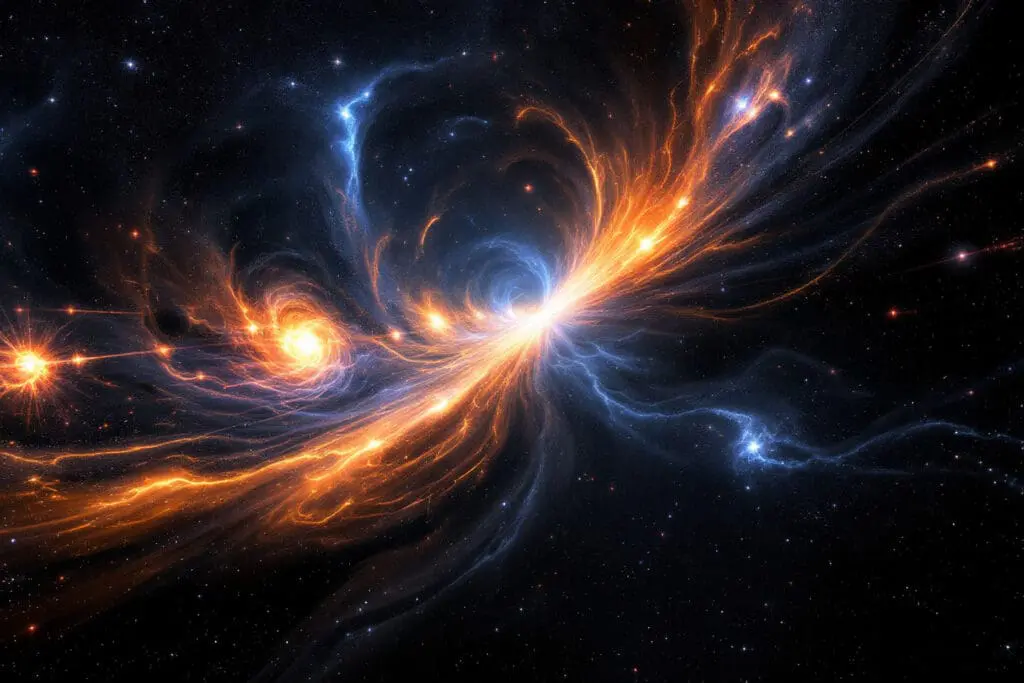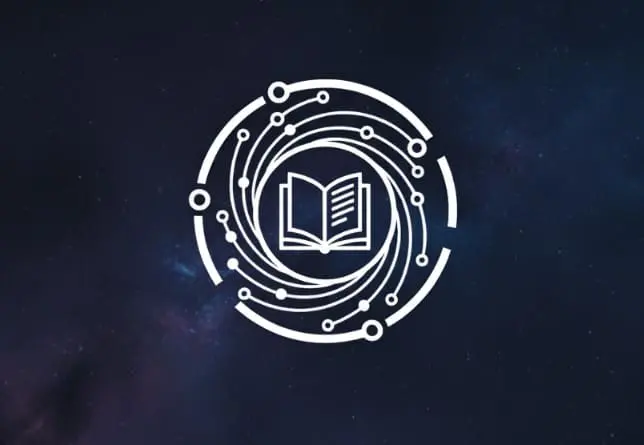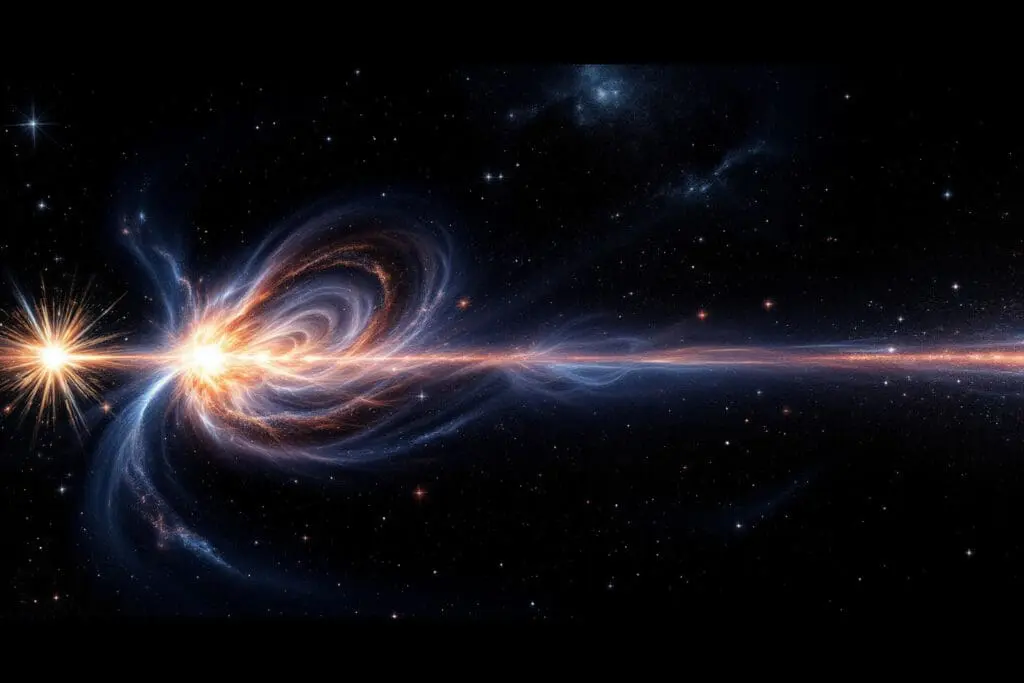Ever find yourself staring up at the night sky, just lost in it? That scatter of stars on black velvet makes you feel small, but in a good way. It’s a feeling that connects us all. We look up into that deep, dark canvas and can’t help but ask the big questions. How did this all get here?
What kicked it all off? And the one that sends a little shiver down your spine: where is it all going? For most of human history, our answers were myths and stories. Now, science—specifically cosmology—gives us answers grounded in evidence, and they’re even wilder than the myths. We’re about to take a trip through the origin and fate of the universe. It’s a story that started 13.8 billion years ago. And it’s nowhere near finished.
More in The Big Picture Category
How Cosmology Explains Our Origin
Key Takeaways
- The Big Bang: Our universe exploded into being 13.8 billion years ago from a point of unimaginable heat and density. It wasn’t an explosion in space; it was the rapid expansion of space itself.
- Cosmic Clues: Two major pieces of evidence back this up: distant galaxies are rushing away from us (something called redshift), and there’s a faint, universe-wide glow of ancient radiation called the Cosmic Microwave Background (CMB).
- The Dark Side: Most of the universe is invisible to us. Dark matter acts like a gravitational glue for galaxies, while a mysterious force called dark energy is speeding up the universe’s expansion.
- The End Game: How it all ends comes down to dark energy. The front-runner theory is a “Big Freeze,” a slow fade to black. But other, more dramatic endings like a “Big Rip” or a “Big Crunch” are still in the running.
So, Where Did It All Begin?
To get our heads around this cosmic tale, we have to hit rewind. Way back. Before Earth, before the sun, before the very first stars blinked into existence. We need to go back to a time before time as we measure it. Right back to the starting line.
What was the Big Bang, Really?
First, get that image of a giant firecracker out of your head. The Big Bang wasn’t an explosion happening in space. It was the beginning of space. And time. And every bit of stuff in it.
Try to picture it. Every star, galaxy, and planet you’ve ever seen, all crushed into a space smaller than an atom. The temperature and density were off the charts. Then, 13.8 billion years ago, it started expanding. Fast. But things weren’t flying out from a central point. The fabric of space itself was stretching, carrying everything with it for the ride. From that tiny, hot point, the universe has been expanding and cooling down ever since. That’s the Big Bang.
It sounds like science fiction. But the proof is written in the stars.
How Can We Be So Sure This Actually Happened?
You don’t just cook up a story like that without some serious evidence. Luckily, the universe wasn’t great at cleaning up after itself. It left clues scattered all over the cosmos, little breadcrumbs that lead us right back to that fiery start. Scientists have spent decades following the trail.
Is There a Faint Echo of Creation We Can Still Detect?
Back in the 1960s, two radio astronomers named Arno Penzias and Robert Wilson found something they couldn’t explain. A stubborn, faint hiss was messing with their equipment, and it was coming from every single direction in the sky. They tried everything to get rid of it, but it wouldn’t go away. What they thought was a glitch was actually the oldest sound in the universe.
They had found the Cosmic Microwave Background (CMB).
This radiation is the leftover heat from the creation of the cosmos, a snapshot from when the universe was only 380,000 years old. Before then, the universe was a hot, foggy mess of particles. As it cooled, the fog cleared, and light was able to travel freely for the first time. That ancient light, stretched out by billions of years of expansion, is what Penzias and Wilson picked up. It’s the universe’s baby picture.
Why Do All the Galaxies Seem to Be Running Away From Us?
Around the 1920s, an astronomer named Edwin Hubble was looking at distant galaxies and noticed something odd. Their light was shifted toward the red end of the spectrum. You know how an ambulance siren sounds higher when it’s coming at you and lower when it’s going away? That’s the Doppler effect. Light does the same thing. When something is moving away from you, its light waves get stretched out, making them look redder.
Hubble saw that almost every galaxy was redshifted. More than that, he realized the farther away a galaxy was, the faster it was speeding away. This didn’t mean we were at the center of a great cosmic breakup. It meant the entire universe was expanding. Every galaxy is moving away from every other. It was the first hard proof that our universe had a dynamic beginning.
What Happened in Those First Few Moments?
That first second after the Big Bang was pure chaos and creation. It was a flurry of activity that set the rules for the next 13.8 billion years. We can’t see it, but we can use physics to figure out what that frantic, formative time was like.
Can We Piece Together the Universe’s Baby Pictures?
In a split-second after the Big Bang, the universe went through a massive growth spurt called “inflation.” It swelled from the size of an atom to bigger than a grapefruit almost instantly. This event smoothed out all the wrinkles in spacetime and planted the seeds for the massive galactic structures we see today.
Within three minutes, it was cool enough for the first building blocks of matter to form, creating a universe made almost entirely of hydrogen and helium. The amounts we see today are a perfect match for what the theory predicts. For the next 380,000 years, this soupy plasma expanded and cooled until, finally, the fog lifted, atoms formed, and the CMB was set free. The universe as we know it was starting to take shape.
What Is the Universe Actually Made Of?
Look out into space, and you see stars, planets, and glowing clouds of gas. That’s all “normal” matter. But here’s a humbling thought: all the stuff we can see, all the normal matter in the universe, makes up less than 5% of everything. The other 95% is a complete mystery, split between two invisible components: dark matter and dark energy.
Why Is There So Much Stuff We Can’t Even See?
Astronomer Vera Rubin was studying how galaxies spin back in the 70s. She figured the stars on the outer edges should be moving slower than the stars in the center, just like Pluto plods along compared to Mercury. But she saw something that made no sense. The outer stars were moving just as fast as the inner ones.
The only explanation was that the galaxy was surrounded by a massive, invisible halo of “stuff” whose gravity was holding those speeding stars in their orbits. They called it “dark matter.” It doesn’t give off light or heat. We only know it’s there because we can see its gravitational tug on everything else. It’s the invisible skeleton that our universe is built on, and it makes up about 27% of the cosmos. We still don’t know what it is.
What’s Pushing Everything Apart Faster and Faster?
For decades, everyone thought the universe’s expansion must be slowing down, with gravity acting like a cosmic brake. Then, in 1998, two teams of scientists discovered something that blew everyone’s minds. The expansion isn’t slowing down. It’s speeding up.
Some strange force is pushing spacetime apart, winning the fight against gravity. They named it “dark energy.” It seems to be a property of space itself—as space expands, more dark energy appears, pushing things apart even faster. This is the heavyweight champion of the cosmos, making up a whopping 68% of everything. It’s also the single biggest puzzle in physics.
Now That We Know the Origin, Where Is It All Headed?
Figuring out the beginning is only half the battle. The other half is the end. The fate of the universe is being decided by a massive cosmic tug-of-war. In one corner, you have gravity, pulling everything together. In the other, you have dark energy, pushing it all apart.
Who wins will write the final chapter of our universe.
What Are the Possible Endings for Our Universe?
Right now, there are three main theories on the table for how this all could end. Each one describes a future so distant it’s hard to comprehend. The path we’re on depends completely on the true nature of dark energy.
Will the Universe Just Fade into a Cold, Dark Nothingness?
This is the “Big Freeze,” and it’s the current favorite. If dark energy is a constant, steady force, then the universe will just keep expanding and accelerating forever.
Trillions of years from now, all other galaxies will have rushed away so far and so fast that their light will never reach us. The night sky will be pitch black. Our own local stars will burn out one by one, leaving behind a graveyard of black holes and dead stellar corpses. Eventually, even that stuff will decay. The universe will become a vast, frigid, and eternally dark place. A quiet, lonely end.
Could the Universe Be Torn Apart at the Seams?
Then there’s the “Big Rip,” a much more violent scenario. This happens if dark energy isn’t constant—if it actually gets stronger over time.
If that’s the case, the acceleration will run wild. Eventually, the push of dark energy will become stronger than gravity. It will tear galaxy clusters apart, then the galaxies themselves. The force will rip planets from their suns and then shred the suns themselves. In the final, chaotic moments, it would be strong enough to tear apart atoms, reducing the entire universe to a spray of fundamental particles.
Might Everything Collapse Back in on Itself?
Before we discovered dark energy, the “Big Crunch” was the leading idea. It’s the theory that gravity eventually wins.
The expansion would slow, stop, and then reverse. Everything would start rushing back together. The universe would get hotter and denser as it collapsed, essentially becoming the Big Bang in reverse. It would all end in an infinitely hot, dense point. Some even wonder if that could trigger a “Big Bounce,” a new Big Bang that starts the whole cycle over again.
So, Which Fate Is the Most Likely?
Right now, the evidence is pointing to the Big Freeze. Our measurements show dark energy behaving like a constant, unchanging force. That puts us on the path to a future of endless, accelerating expansion into cold and darkness.
But we shouldn’t get too comfortable. We’re still in the dark about dark energy and dark matter. New tools like the James Webb Space Telescope are giving us a clearer view than ever before, but the story isn’t over. The final sentence on the fate of the universe has not yet been written.
An Unfolding Story
Trying to understand the origin and fate of the universe is the ultimate human quest. It’s a story that starts with a bang and ends in a whisper. From that initial searing flash to a potential future of cold darkness, science has revealed a cosmos that’s more awesome and humbling than we ever could have imagined.
We just happen to be alive at a perfect moment—long after the chaotic beginning but long before the lonely end, in a universe filled with light and life and wonder. We are the part of the universe that gets to look back and piece the story together. And the best part is, there are still so many secrets left to uncover.
FAQ – Origin and Fate of the Universe

What are the possible futures of the universe according to current scientific theories?
The universe could end in a ‘Big Freeze’ with endless expansion and cooling, a ‘Big Rip’ where dark energy tears everything apart, or a ‘Big Crunch’ where gravity causes everything to collapse back into a dense state, depending on the nature of dark energy.
Why do galaxies appear to be rushing away from us, and what does this signify?
Galaxies appear to be rushing away due to the universe’s expansion, indicated by redshift in their light. This shows that space itself is stretching, and it supports the idea that the universe had a beginning in the Big Bang.
How did scientists discover the Cosmic Microwave Background radiation?
Scientists Arno Penzias and Robert Wilson discovered the Cosmic Microwave Background in the 1960s as a faint, uniform radiation coming from all directions in the sky, which is the residual heat from the universe’s early formation.
What evidence supports the Big Bang theory?
Supporting evidence for the Big Bang includes the observation that distant galaxies are moving away from us (redshift) and the detection of the Cosmic Microwave Background radiation, which is the leftover heat from the early universe.
What is the Big Bang theory and how does it explain the origin of the universe?
The Big Bang theory suggests that the universe began approximately 13.8 billion years ago from an extremely hot and dense point, not as an explosion in space but as the rapid expansion of space itself, leading to the current expanding cosmos.

